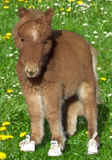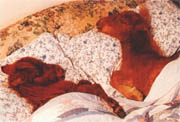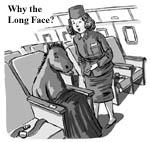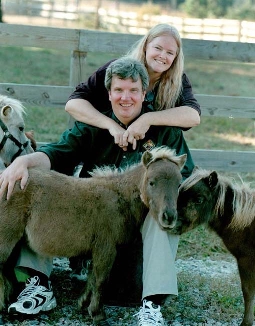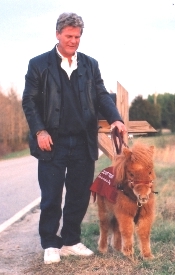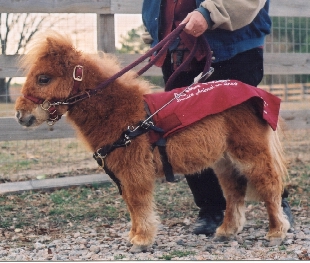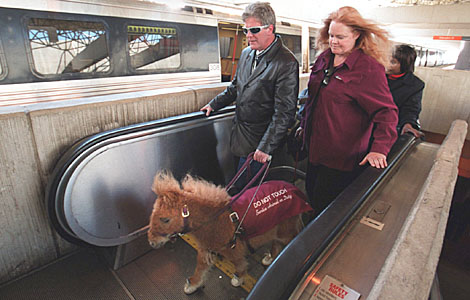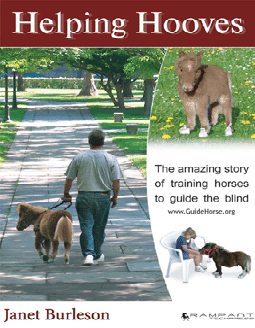Decked out in pants and a cowboy hat,
Grahmann trekked with the Burlesons, who own this 63-acre Kittrell
horse farm, and her mother to a field where she could ride. Two
young women brought out Raspberry Jam, who was a champion show horse
in his younger days, and stacked a short set of black steps at his
side. Grahmann folded her cane and handed it to her mother. With
help, she climbed the steps and mounted.
"Horses have been guiding people for centuries," Don Burleson
said. People just have to trust them, he said.
Grahmann and Raz started out walking, then they trotted along a
wooden fence. They galloped for a few steps, then lost their stride.
They hadn't found their rhythm. "She's ready to open up," said Mary
Lou Russell, anxiously watching her daughter. "I can tell."
Grahmann turned the reins to direct Raz back to where they
started and tried again. The pair did a little better this time,
loping for a short while.
"There she goes," said Janet Burleson, watching them. Sending
good vibes across the distance, she said, "Keep him going."
Grahmann and Razz traveled even farther.
"OK, buddy," said Grahmann, bringing him in. "That was good."
Looking at Grahmann's ease with Raz, you wouldn't know how far
she has come to get here. It's a journey across space and through a
tangle of emotions. Before this morning, Grahmann hadn't loped a
horse in eight years. She hasn't connected with one since 1990 when
her kindred spirit, Rebel, died. The former trophy-winning rider
traveled from southeast Texas to the Burlesons' farm to meet a
miniature horse that will this fall become her guide animal and
maybe something more.
Th rough the Burlesons, Grahmann holds hope that she'll find that
old closeness, that bond she feared was lost forever, with the mini
they trained named Pal. "Yesterday, the first time out with me, he
stopped me from continuing forward because there was a car coming,"
Grahmann said. "I kept saying, 'Forward, forward.' He was saying,
'Unh, unh.' "
Grahmann was in the eye doctor's office early this year with her
mom when Russell read her an article on the Burlesons' nonprofit
Guide Horse Foundation. Right away, Grahmann knew she had to have
one. She had considered getting a guide dog once. But she already
has four canines and feared that having another one, especially one
allowed to sleep inside, might cause jealousy and problems. Plus,
she missed bonding with horses. Ever since her Rebel died, Grahmann
felt an ache. She wondered whether it was time to risk being
vulnerable again.
With her text enlarger, Grahmann filled out the application from
the Burlesons' Web site,
www.guidehorse.com
, and waited. About a month later, the Burlesons contacted her and
planned a trip to her home to meet her.
The couple are choosy about whom they trust with their horses.
Just four years ago, the Burlesons had an incredible idea -- to
successfully train a miniature horse to lead the sight-impaired .
People scoffed at the notion. But the Burlesons proved their hunch
right with an experimental project in 1999 and started a series of
firsts. Janet became the first person in the world to train a guide
horse and then trained the first guide horse to enter full-time
service with a blind person. Following their example, a handful of
people are now training guide horses in other parts of the world.
Not everyone can manage a guide horse, Don said. The person must
have a sense of navigation. It's a misconception, Don said, that a
guide animal will, without direction, take a person where he wants
to go. The new owner also must have enough yard for the horse and
its companion mini to graze and a caring heart. Grahmann passed the
first test. Now, she was in the second phase -- training.
The Burlesons, who give away the miniatures they train, paid for
Grahmann to fly to Kittrell and meet her guide horse. Grahmann knelt
down when they brought in Pal, a 90-pound, 26 -inch buckskin
gelding, and started showing him love, feeding him mints, which to
her delight he slurped. She felt a familiar tingle.
The next day, she was ready to see him again. "How are you doing,
boy?" Grahmann asked when Pal came into the Burlesons' home a little
later on a leash. He licked her fingers searching for a treat.
Grahmann and Pal had already navigated a quiet park, learning to
work together. Pal's job was to keep Grahmann safe and Grahmann's
job was to tell Pal where she wanted to go. Today, they were
tackling an urban scene. Each time they train, they'll go somewhere
different, Don said. A guide horse must be able to handle any
situation. Plus, once a horse learns a route, he said, he knows it
for good.
The group piled into Don's white Dodge Caravan heading for
Henderson. Donna sat in the front with Don. Pal stood on the back
floor -- his moving litter box -- with Don's daughter, Jennifer, and
a friend.
Don parked on a commercial strip of Garnett Street. The girls,
volunteers for the summer, laid down wooden slats. Then out padded
Pal over the makeshift ramp and onto the pavement in his white baby
shoes split to accommodate his hooves and white socks (practice for
when he walks on slick surfaces such as mall floors). Drivers craned
their necks when they saw him. Passers-by did double takes . The
teens tied a maroon bandanna around Pal's neck and laid a blanket on
his body that read "Do Not Touch. Service Animal on Duty."
"We're ready to rock and roll," Don said.
Grahmann held onto Pal's harness and reins. Janet, who has
trained horses for decades, walked next to her to help them along.
They headed down the sidewalk, past shops, by other people, through
crosswalks. After coaching Donna for a while on how to use verbal
commands such as "forward" and "wait" to communicate with Pal (they
will know 23 commands when training ends), Janet started lagging.
"We're all still here, Donna," Janet said. "We'll just stay back
a bit and let you go."
Grahmann and Pal went their way alone. The pair bumped into each
other gently at first, but then walked down the sidewalk, steered
around a tree and kept going, just the two of them together,
managing on their own.
"Good boy," Donna said with a smile, patting Pal when they
stopped near a beauty salon.
A group of youths looked on in amazement. They asked if they
could take a picture of Grahmann and Pal. The pair posed as people
from Beauty Express peeked out the door and the yellow disposable
cameras of the young men clicked.
The young men crossed the street, glancing back now and then with
wide eyes, still talking about what they saw.
An idea from Twinkie
The Burlesons didn't set out to make history. Don, who already
had a couple of minis as pets, spotted a 2-foot dwarf miniature
horse at an auction in Mount Airy. Don entered the bidding, set on
taking that mini home. "When it got to $900, Janet started nudging
me," Don said. "She said, 'What will you do with it?' She thought I
was nuts."
Don paid $950. He started treating his pet, Twinkie, like a dog,
loading him up in his minivan and taking him places like the flea
market. Don knew he was special right away. Twinkie loved people. He
was intelligent and was a natural guide. By instinct, horses are
cautious of danger. At the flea market, Don noticed how Twinkie led
him around obstacles.
One day, Don and Janet batted ideas around. The pair thought
about Twinkie and about the horses they rented in Manhattan, who
maneuvered around traffic, undaunted by blaring horns and city
noise, from the livery stable to Central Park and back to the
stable. Then Janet, a champion rider and trainer since her youth,
thought back to her early days. As a teen, she had watched a blind
woman showing a horse once. The trust and bond between them amazed
her. Could they train miniature horses to lead the blind?
"We were laughed at and got everything from skepticism to
amazement when we first started," Don said. "Some people said,
'You'll never be able to housebreak a horse.' A lot of people didn't
understand horses. They had already been guiding people at the turn
of the century. People back then understood."
They set to work on Twinkie. Don, who has a degree in
experimental psychology, had the know-how in memory theory and
conditioning. Janet, whom Don calls a horse whisperer, had the
experience in training around behavior challenges and getting the
response she wanted.
Janet, with Don helping out, devoted hundreds of hours,
housebreaking Twinkie, teaching him to ride an elevator, navigate in
traffic, spook in place (remain calm in noise and chaos), practice
intelligent disobedience. If the blind person commands the horse to
go and there's danger, the horse has to have the smarts to stop
anyway and protect his charge. They were training with him in
Crabtree Valley Mall in Raleigh one day when someone at a local
television station spotted them.
That set off the national sensation. The couple have been
featured on everything from "Ripley's Believe It Or Not!" and
"20/20" to the children's magazine Highlights and the "Today" show.
They never planned to put the guide horses into practice. But in
2000, Dan Shaw of Maine heard a woman on TV talk about the guide
horse she had trained. Shaw, who had considered guide dogs, made up
his mind that he needed one. He found the Burlesons' number and
called.
"He pestered us incessantly," Don said. "We had never planned to
place horses. We just wanted to see if it could be done."
As word spread, donations poured in to buy the minis from
breeders. Children mailed their allowances. Celebrities sent
anonymous monetary gifts. Stores donated products. When they don't
get donations, Don, who has written more than 30 technical computer
database books, and Janet, a Web design consultant, pay for
everything themselves.
Novelist Patricia Cornwell, who asked to be blindfolded and
guided around with a Burleson mini, donated several miniatures,
including Cuddles, the one they trained for Shaw. Twinkie, who had
the necessary intelligence and excellent health, did not have the
agility to be an official guide horse. Just one or two in 100
miniatures have what it takes.
"Cuddles has changed every aspect of Dan's life," Don said. "He
went from being introverted to bold and outgoing. It's gratifying to
see how animals can change owner s' lives. After Dan, the phone was
ringing off the hook with blind people from all over the country. We
had blind people crying on the phone, trying to bribe us, cajole us.
There's lots of need out there."
After Shaw, training guide horses became a mission for the
Burlesons. They give their time for free. Their foundation pays for
the guide horse training, follow-up visits, trips for the
sight-impaired person to practice with the horse. The recipient of
their gift pays nothing. For the Burlesons, the reward is watching
the guide horse and blind person grow together. The Burlesons will
place two miniature horses this year, one with Grahmann and one with
a woman in Pennsylvania. They're in no rush to place more. Building
trust with the horses and with the blind handlers takes time. The
Burlesons are training horses who will be entrusted with someone's
life. They know what a weighty duty that is. They've pledged to
nurture those relationships for the rest of their lives.
Lifelong love of horses
Sitting in the Burlesons' living room, decorated with horse
pillows, golden horse figurines and framed pictures of mares on the
walls , Donna talked about how she got here. She fell for horses the
first time her parents took her to ride a pony around a circle in
downtown Houston. "Ever since I could say horse," Grahmann said, "I
wanted one."
She got Rebel, a bay quarter horse, in 1977. Her mother remembers
when Grahmann spotted him.
"He was in a stall and had his head down," she said. "Just when
Donna got to the stall, he raised it. He had the most gorgeous eyes.
She gasped."
The next year, Donna and Rebel won the state championship in pole
bending. Together, they've placed in a world youth competition in
the stake race and in the Quarter Horse Congress in trail, pole
bending, barrels and western riding. Along with sharing moments of
glory, Grahmann was with Rebel at one of her worst moments too.
"I was sitting on Rebel at a horse show looking at lights on the
ceiling waiting for my turn," said Grahmann, who was in her early
20s. "The light turned orangey-red. My eye was hemorrhaging."
Grahmann was losing her sight to diabetic retinopathy, an eye
disease caused by complications from diabetes. A specialist wasn't
able to save her right eye. A letter came from a doctor telling her
that one day she would be totally blind. "I knew it would happen one
day," she said. "But seeing it in black and white was hard. It shook
me up."
By 1989, Grahmann was legally blind in her left eye too. She kept
riding. Rebel was her vision. Grahmann and Rebel knew every move the
other would make. He adjusted for her movements in the saddle. They
even ran poles together. Don compared it to skiing slalom. Grahmann
felt safe in any situation. "I could pretty much just sit there,"
she said. "I knew if I was starting to slip out of the saddle, he'd
slow down. I trusted him with my life."
When Rebel was struck by lightning the next year and died,
Grahmann felt empty. "I knew I'd never have another connection like
that," she said. "I had one other horse after Rebel and it wasn't
the same."
She struggled to manage on her own. In unfamiliar places, she
grabbed her husband's elbow or her mom's. When her husband dropped
her off at the grocery store, Donna bravely entered but trembled
inside. She cringed when she knocked over orange cones and displays
in the aisles. She lost hope of ever finding another horse with whom
she could have that special bond. Rebel would guide her around the
low limbs and trees on her property. She didn't know what a new
horse would do.
"I didn't trust them or myself," she said.
Grahmann still mourns Rebel. She has a painting of the two of
them in her bedroom. The trophies they won together are around her
house. "I don't think I'll ever get over losing him," she said. "He
was like my child."
But maybe she can make room in her heart for one more. With
Rebel, it was love at first sight. With Pal, she could make out the
length of his body, but couldn't tell what color his mane and tail
were. It didn't matter. Instinct told her he was special. Grahmann
knows that, like Rebel, he can help her feel independent and free.
"I'm just ready to have another animal like that in my life," she
said.
Learning to trust
On her last day in North Carolina, Grahmann rode some more on Raz.
This time, they loped easily along the fence. Stoked, Grahmann went
inside to start another day with Pal. When he trod in, she greeted
him like an old friend. Grahmann blew gently near his nostrils.
"When two horses meet, they blow puffs of air at each other," Don
said.
She fed him a piece of ice from her glass of water, holding it in
her hand and letting him lick it through her fingers until they
dripped. "I was amazed yesterday," Grahmann said, "at how he was
leading me around trees. Once I got close to them, I could see them
but I didn't want to give him commands. I wanted to see if he could
do it and he did."
It's like Rebel, Russell said. He would accommodate Donna and
keep her safe. She slipped once from his back when he made a sharp
turn running polls. "You've never seen a horse shake so bad,"
Russell said. "He didn't stop shaking until he could put his head on
Donna."
Russell thinks that Donna and Pal will forge that kind of
connection. There are already signs -- the way Grahmann gleams when
he enters, the ease with which Pal took to her.
"I think it will develop to that," Grahmann said. "I already got
him in my heart."
The day's lessons started at PETsMART. "OK," Donna said,
confidently, holding onto Pal's reins, "which way is the store?"
"Forward, forward," she told Pal, clicking her teeth.
"When they complete training," Janet said. "Donna will be able to
just say, 'Find the door.' "
Inside, people gawked. A little girl tugged on her mother's arm.
"Mommy, it's a pony," she said.
Pal never faltered. Together, Grahmann and Pal navigated the
store's aisles, past the bird cages and aquariums. Down each row
were different obstacles. A doggie bed sat in the middle of one; a
tall ladder was at the center of another. Together, they made it
around each hurdle. Pal stayed still at a hefty stack of dog food
that left just a narrow passageway for the two of them. Grahmann
nudged him with her knee to encourage him forward. Reluctantly, he
continued. Grahmann bumped her arm on the edge of one aisle.
"He was telling you it was too tight," Janet said.
By the time they go home together in October, they will know each
other's language. On the way back to the van, a car stopped to allow
them to pass in front of them. Pal chose the safest way -- behind
it. This time, Grahmann followed him.
The Burlesons and Pal took Grahmann and her mother to the
airport. The pair practiced on moving sidewalks and elevators,
maneuvering through crowds before it was time to part.
Grahmann checked in at the gate. She won't see Pal again for a
while. Grahmann will return for her last training session -- even
more intense work of learning how to use Pal safely and mastering
techniques -- right before she takes him home. Guide horses have to
be 100 percent proficient at traffic training before the Burlesons
turn them over to their blind handlers. A misstep, Don said, could
mean someone's life. They will work with Pal while Grahmann is gone
to make sure he's ready. The trust must be absolute.
"A guide horse and a blind person develop a symbiotic
relationship," Don said. "They become one."
The group headed to the place where they would say goodbye.
Grahmann knelt and rubbed Pal's caramel-colored coat. Pal warmed to
her attention.
"I hope he remembers me when I get back," she said.
She and Russell headed toward security. Grahmann took one final
look, waving and beaming until she disappeared from sight.
